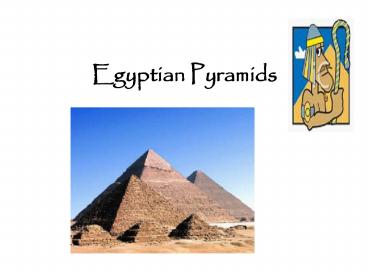Egyptian Pyramids - PowerPoint PPT Presentation
1 / 14
Title:
Egyptian Pyramids
Description:
Pyramids of Giza Only 7th Wonder of the Ancient World still standing Every pyramid has been plundered The pyramid was the vessel in which the pharaoh ascended into ... – PowerPoint PPT presentation
Number of Views:387
Avg rating:3.0/5.0
Title: Egyptian Pyramids
1
Egyptian Pyramids
2
Mastabas
- Mastabas were early one level tombs with sloping
walls so that the flat roof was actually smaller
than the base - The word Mastaba comes from the Arabic word
meaning stone bench - Earliest were made of unfired mud brick
- Over time the interiors became more ornate, with
decorative scenes (feasting, agriculture,
dancing, etc.) to ensure the dead would want for
nothing in the afterlife
3
Step Pyramid
- The first pyramid built by Pharaoh named Djoser
- Located at Saqqara near Memphis
- Built by architect Imhotep regarded as the
father of Egyptian architecture, sculpture and
Medicine - Step pyramid had 6 tiers
- Based on mastaba construction smaller mastaba
placed on top of larger ones - Djoser is buried under the pyramid in a burial
chamber
4
Bent Pyramid
- The Bent pyramid is a pyramid started that
started at one angle (approx. 52 degrees) and
then suddenly changes to a more gradual angle of
43 degrees. This odd arrangement provides this
pyramid with a distinctive and unique appearance.
There are several possible reasons for this
change in angle. Currently, the most widely
accepted theory is that King Sneferu realized
that if he were to continue the pyramid at its
initial angle, it would rise to a height which
would require a tremendous amount of material and
labor. Another theory holds that the original
angle resulted in displacement of many blocks and
cracking of the blocks that lined the chambers
and passageways. This theory continues that the
gentler angle was employed to reduce the amount
of weight to be added above these chambers and
passageways.
5
Pyramids of Giza
- Only 7th Wonder of the Ancient World still
standing - Every pyramid has been plundered
- The pyramid was the vessel in which the pharaoh
ascended into the heavens and the afterlife. - The pyramids at Giza were built on a limestone
plateau to be higher than the Nile flood plain.
- Pyramids were built using basic tools and
equipment
6
The Great Pyramid
- Built for Pharaoh Khufu (son of Snerfu bent
pyramid guy) - Located at Giza near Cairo
- True pyramid smooth sides and limestone casing
- Limestone later stolen and used to build Cairo
- Burial chamber and inner passages made of
granite - Took over 20 years to complete
7
Pyramid of Khafra
- Son of Khufu
- Only pyramid with any limestone casing left
- Looks larger than Khufu, but actually built on
higher ground giving it the impression of being
bigger - Large red granite sarcophagus still in the burial
chamber - Sphinx stands in front of Khafras pyramid
8
Sphinx
9
Pyramid of Menkaure
- Son of Khafra
- Smallest of the three pyramids
- Last pharaoh to be buried at Giza
10
Notes on Pyramids
- Means House of Eternity
- Comes from Greek word pyramis meaning wheat
cake - Ancient Egyptians called them mer
- Built on west bank of Nile sun sets in west
land of the dead - Designed to protect the body of the pharaoh
from - Thieves
- Wild animals
- Floods
- Building pyramids
- farmers worked on pyramids during flood season
(3 months a year) upwards of 100,000 farmers and
4,00 stone masons - copper tools to cut out granite and limestone
- wooden sleds to move block
- built ramps of mud and stone to move block up
pyramid - Top of pyramid capped with a pyramidion (Greek)
or benben (Egypt.)
11
Valley of the Kings
- Due to the fact that all of the pyramids were
pillaged and robbed (70 known pyramids)
Egyptians looked for an alternative to ensure a
good afterlife for their pharaohs Began
building tombs in the Valley of the Kings
12
(No Transcript)
13
(No Transcript)
14
The End































